Grove Hall
Fairfield Road, Bow, E3 2SY
Medical
dates:
Medical
character:
Mental (Licensed House)
At the beginning of the 1820s
Edward Byas leased Grove Hall, a large mansion built sometime in the
first half of the 18th century and surrounded by 12 acres of grounds.
The building had previously been used as an academy for boys, run
by the Revd Dr James Lindsay until his death in 1821.
Mr Byas added some additional outbuildings and opened a 'pauper farm'.
By 1841 the pauper farm contained 116 inmates.
In 1844 Mr Byas opened part of the main building as a Licensed House - a private lunatic asylum - with a weekly charge of 5 to 6 shillings (25-30p), far cheaper than any other asylum.
However, the fees soon increased and, by 1845, the weekly charge was 11 shillings (55p), compared to the Hanwell Asylum, which charged 9 shillings and 9 pence (48p).
In 1846 the institution had 250 patients and 308 in 1847. An outbreak of cholera occurred in 1848.
In 1849 there were 400 inmates, of whom 391 were paupers (246 female and 145 male) and 9 private patients (5 male and 4 female).
In 1851 the Lunacy Commission decided to reduce the number of paupers being sent to pauper farms. In view of this, Mr Byas increased the number of pensioners admitted, that is, persons who were in receipt of small annuities or pensions. First class pensioners paid 12 shillings (60p) a week, second class 9 shillings (45p) and third class 6 shillings (30p) (the latter had to share a bed). Board and lodgings, and laundry, were included in the price but they had to provide their own towels and cutlery.
In 1852 Dr Alonzo Henry Stocker was appointed as the Medical Superintendent. Despite being only 22 years old, he considerably improved the conditions of patient care.
In 1853 the weekly charges for a patient were 15 shillings (75p), 21 shillings (£1.05) or 30 shillings (£1.50).
In 1853, compelled by the County Asylums Act, 1845, the County of Essex opened its own asylum at Warley. All the Essex paupers in Grove Hall were transferred there.
In May 1854 the Naval Lunatic Asylum at Yarmouth, which was temporarily housing military lunatics, was repossessed by the Admiralty for use as a general hospital for sailors of the Baltic fleet. The remaining 69 soldiers and 5 women were transferred to Grove Hall, which was considered to be a well-run asylum.
By 1856 it had become difficult for private asylums to compete financially with the county asylum system, and Mr Byas approached the military authorities with a view to take in their mad to fill the places (the Crimean War (1853-1856) had greatly increased the number of soldiers, and hence the number of those who became insane during their military service). Because of the lack of provision of a military asylum for discharged military lunatics, the Secretary of War came to an agreement with the asylum for the reception of insane soldiers.
In 1858 the asylum contained 352 inmates, of whom 168 were paupers.
In 1859 there were 359 inmates - of whom 173 were paupers, paid for by various Boards of Guardians, and 186 private patients (including the military ones).
By 1860 the asylum contained 118 military lunatics, paid for by central government.
In 1867 the asylum consisted of the original mansion and various wards and outbuildings which had been added as accommodation. Half the inmates were private patients and the other half paupers. In the male wing there were 257 patients, of whom on average 216 were mentally ill ex-soldiers. They were looked after by 15 day attendants and 1 night attendant. In the female wing, which had 131 patients, the staff consisted of 12 day nurses and 1 night nurse.
Patients were provided with entertainments and dances in the wards. In the summer, groups of patients (numbering from 60 to 70) were taken for picnics in Epping Forest.
In 1870 the asylum was licensed for 452 patients.
In 1872 Dt Stocker left to go to Peckham House and was replaced by Dr William Julius Mickle (1845-1918) as Medical Superintendent. Dr Mickle, a Canadian, was particularly interested in brain disease due to syphilis or tropical conditions, such as sunstroke and arterial degeneration. He was one of the first to point out the relationship between general paralysis of the insane (G.P.I.) and syphilis.
At the beginning of 1874 the asylum contained 416 private patients and 8 paupers (all male).
In 1879 it was the largest Licensed House in London, with 443 inmates. It was licensed to Mr Edward Hezley Byas and Dr Mickle and catered mainly for ex-servicemen, whose maintenance was defrayed by the War Department. The military patients were kept distinct from the civilian ones. Dr Mickle and a junior medical officer were both resident at the asylum.
By 1882 only five Metropolitan Licensed Houses were receiving pauper lunatics, of which Grove Hall was one (the others were Bethnal House, Camberwell House, Hoxton House and Peckham House). The asylum was licensed for the reception of 452 male patients, of whom no more that 450 could be of the private class. By this time it contained only 7 paupers and the rest of the patients were soldiers who had become insane. However, following the Army Discipline and Regulation Act, 1879, the War Department decided to discontinue the arrangement with the asylum, and no new cases were sent.
In 1882 the Commissioners in Lunacy found that the faults they had identified in their previous visits - the untidiness of the attendants and their patients - had been rectified. The patients' diet was liberal and their accommodation generally fair and, in the modern buildings, very good. A gallery of single rooms had been added in the soldiers' quarters. The wages of the attendants were deemed sufficient, but there was a high turnover of staff - the insane soldiers being turbulent and difficult to manage.
By the end of the 19th century the weekly charge for a private (civilian) patient was low, about 25 shillings (£1.25).
The asylum closed in 1905. The remaining 67 ex-servicemen were transferred to Bethnal Green Asylum.
Mr Byas added some additional outbuildings and opened a 'pauper farm'.
By 1841 the pauper farm contained 116 inmates.
In 1844 Mr Byas opened part of the main building as a Licensed House - a private lunatic asylum - with a weekly charge of 5 to 6 shillings (25-30p), far cheaper than any other asylum.
However, the fees soon increased and, by 1845, the weekly charge was 11 shillings (55p), compared to the Hanwell Asylum, which charged 9 shillings and 9 pence (48p).
In 1846 the institution had 250 patients and 308 in 1847. An outbreak of cholera occurred in 1848.
In 1849 there were 400 inmates, of whom 391 were paupers (246 female and 145 male) and 9 private patients (5 male and 4 female).
In 1851 the Lunacy Commission decided to reduce the number of paupers being sent to pauper farms. In view of this, Mr Byas increased the number of pensioners admitted, that is, persons who were in receipt of small annuities or pensions. First class pensioners paid 12 shillings (60p) a week, second class 9 shillings (45p) and third class 6 shillings (30p) (the latter had to share a bed). Board and lodgings, and laundry, were included in the price but they had to provide their own towels and cutlery.
In 1852 Dr Alonzo Henry Stocker was appointed as the Medical Superintendent. Despite being only 22 years old, he considerably improved the conditions of patient care.
In 1853 the weekly charges for a patient were 15 shillings (75p), 21 shillings (£1.05) or 30 shillings (£1.50).
In 1853, compelled by the County Asylums Act, 1845, the County of Essex opened its own asylum at Warley. All the Essex paupers in Grove Hall were transferred there.
In May 1854 the Naval Lunatic Asylum at Yarmouth, which was temporarily housing military lunatics, was repossessed by the Admiralty for use as a general hospital for sailors of the Baltic fleet. The remaining 69 soldiers and 5 women were transferred to Grove Hall, which was considered to be a well-run asylum.
By 1856 it had become difficult for private asylums to compete financially with the county asylum system, and Mr Byas approached the military authorities with a view to take in their mad to fill the places (the Crimean War (1853-1856) had greatly increased the number of soldiers, and hence the number of those who became insane during their military service). Because of the lack of provision of a military asylum for discharged military lunatics, the Secretary of War came to an agreement with the asylum for the reception of insane soldiers.
In 1858 the asylum contained 352 inmates, of whom 168 were paupers.
In 1859 there were 359 inmates - of whom 173 were paupers, paid for by various Boards of Guardians, and 186 private patients (including the military ones).
By 1860 the asylum contained 118 military lunatics, paid for by central government.
In 1867 the asylum consisted of the original mansion and various wards and outbuildings which had been added as accommodation. Half the inmates were private patients and the other half paupers. In the male wing there were 257 patients, of whom on average 216 were mentally ill ex-soldiers. They were looked after by 15 day attendants and 1 night attendant. In the female wing, which had 131 patients, the staff consisted of 12 day nurses and 1 night nurse.
Patients were provided with entertainments and dances in the wards. In the summer, groups of patients (numbering from 60 to 70) were taken for picnics in Epping Forest.
In 1870 the asylum was licensed for 452 patients.
In 1872 Dt Stocker left to go to Peckham House and was replaced by Dr William Julius Mickle (1845-1918) as Medical Superintendent. Dr Mickle, a Canadian, was particularly interested in brain disease due to syphilis or tropical conditions, such as sunstroke and arterial degeneration. He was one of the first to point out the relationship between general paralysis of the insane (G.P.I.) and syphilis.
At the beginning of 1874 the asylum contained 416 private patients and 8 paupers (all male).
In 1879 it was the largest Licensed House in London, with 443 inmates. It was licensed to Mr Edward Hezley Byas and Dr Mickle and catered mainly for ex-servicemen, whose maintenance was defrayed by the War Department. The military patients were kept distinct from the civilian ones. Dr Mickle and a junior medical officer were both resident at the asylum.
By 1882 only five Metropolitan Licensed Houses were receiving pauper lunatics, of which Grove Hall was one (the others were Bethnal House, Camberwell House, Hoxton House and Peckham House). The asylum was licensed for the reception of 452 male patients, of whom no more that 450 could be of the private class. By this time it contained only 7 paupers and the rest of the patients were soldiers who had become insane. However, following the Army Discipline and Regulation Act, 1879, the War Department decided to discontinue the arrangement with the asylum, and no new cases were sent.
In 1882 the Commissioners in Lunacy found that the faults they had identified in their previous visits - the untidiness of the attendants and their patients - had been rectified. The patients' diet was liberal and their accommodation generally fair and, in the modern buildings, very good. A gallery of single rooms had been added in the soldiers' quarters. The wages of the attendants were deemed sufficient, but there was a high turnover of staff - the insane soldiers being turbulent and difficult to manage.
By the end of the 19th century the weekly charge for a private (civilian) patient was low, about 25 shillings (£1.25).
The asylum closed in 1905. The remaining 67 ex-servicemen were transferred to Bethnal Green Asylum.
Present status (September 2011)
The house and its gardens were purchased for the public in 1906. The buildings were demolished in 1909 and most of the land was used for the Bow bus garage and housing with new roads. A small part of the gardens, at the junction of Fairfield Road and Bow Road, became Grove Hall Park.
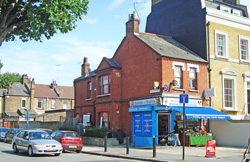
Wrexham Road, leading off Fairfield Road, occupies the site of the driveway to the asylum. There was a Lodge where the shop now stands.
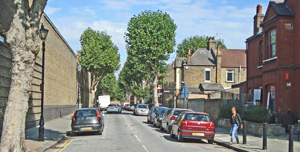
Looking down Wrexham Road, with the bus garage shown on the left in the image.
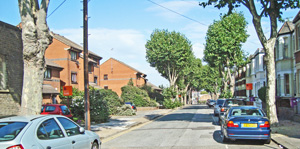
Along Wrexham Road - once the asylum driveway.
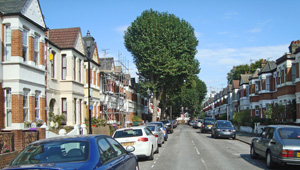
Housing on Ridgdale Road now occupies the asylum site.

Grove Hall Court (unsupported housing for older people) in Jebb Street has 30 apartments.
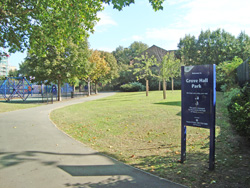
Grove Hall Park occupies the southern part of the asylum grounds.
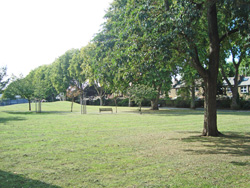
Grove Hill Park (above and below).

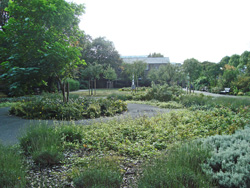
A small memorial garden abuts the Park. It was added as an extension in the 1930s when the garden to St Catherine's Convent was acquired by the Council.
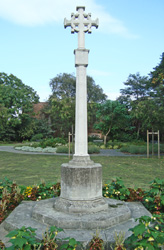
The War Memorial for Bryant & May employees is located in the memorial garden.
(Author unstated) 1853 The British Medical Directory for England, Scotland and Wales. London, Lancet and British Medical Directory.
(Author unstated) 1855 The want of a military lunatic asylum. Asylum Journal of Medical Science 1, 177-178.
(Author unstated) 1879 Lunatics in Licensed Houses. British Medical Journal 1 (15th March), 395.
(Author unstated) 1882 Thirty-sixth Report of the Commissioners in Lunacy to the Lord Chancellor. Parliamentary Papers, 32. London, The House of Commons.
(Author unstated) 1910 Obituary. Dr Alonzo Henry Stocker. British Medical Journal 1 (2575), 1150.
Cherry B, O'Brien C, Pevsner N 2005 London: East. Yale University Press.
Ernset W 1998 Asylum provision and the East India Company in the nineteenth century. Medical History 42, 476-502.
Green DR 2010 Pauper Capital: London and the Poor Law, 1790-1870. London, Routledge.
Jones E, Wessely S 2005 Shell Shock to PTSD: Military Psychiatry from 1900 to the Gulf War. Hove, Psychology Press.
Lockhart Robertson C 1863 The Naval Lunatic Hospital, Great Yarmouth. British Journal of Psychiatry 9, 299-300.
Lockhart Robertson C 1855 The Military Lunatic Hospital. Asylum Journal of Mental Science 2, 31-40.
Murphy E 2003 Insanity in England 1800 to 1870. In: Porter R, Wright D (eds) The Confinement of the Insane, International Perspectives, 1800-1965. Cambridge University Press.
Parry-Jones WLI 2007 The Trade in Lunacy: A Study of Private Madhouses in England in the Eighteenth and Nineteenth Centuries. London, Routledge & Kegan Paul.
http://booth.lse.ac.uk
http://edithsstreets.blogspot.co.uk
http://historyandotherthoughts.blogspot.co.uk
http://wellcomelibrary.org
https://en.wikipedia.org
https://esotericlondon.com
www.jtrforums.com
www.parksandgardens.org
www.towerhamlets.gov.uk
Return to home page